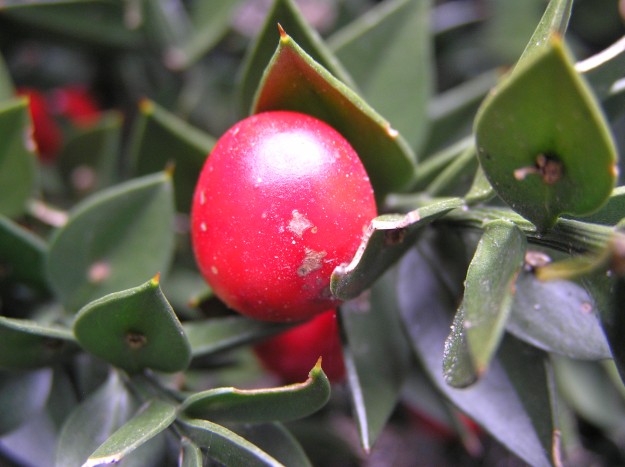Ruscus aculeatus, or Butcher’s Broom, is a woodland shrub native to Europe, it has holly-like leaves and bright red berries. However there is a little more to this plant than meets the eye.
Ancient Woodland Indicator
Ruscus aculeatus is an ancient woodland indicator plant, this means that its presence suggests a wood is more likely to have been around since before 1600.
How old is ancient? The chosen cut-off date, AD1600, around the time of the death of Queen Elizabeth I, is not entirely arbitrary. It marks the beginning of reasonably accurate estate maps, and also the first known widespread tree-plantings. Any wood known to exist in its present form by that date is almost certainly natural in composition even if it was heavily managed. (passage taken from britishwildlife.com, link below)
It is generally true that the older a habitat the more species it will contain and therefore the greater importance it has in nature conservation. However, it is not always easy to know exactly how old woods are; assessing species diversity is complex and documentation about an area is rarely complete, so alternative methods have been found using plants. Some vascular plants are known to not grow well in secondary woodland, and are often found in woods known to be ancient, so conclusions have been drawn that the presence of these plants suggest an older wood. This is not a foolproof indicator and the plants that show such growth habits are different in different parts of the country and on different soils, however, to botanists who have learned to study the signs, Ancient Woodland Indicators are an important clue to the history of the area.
Leaves and Cladodes
Ruscus aculeatus is, at first glance, a fairly straightforward plant, it has pointed flat leaves, like a small leaved holly, a typical dicotyledon (more information about dicotyledons). However, looking more closely at the leaves, they are a little odd, firstly they are not horizontal to maximise the sun’s rays, they are end on. Secondly, the leaves have no evidence of veins, there is a slight crease down the middle, but not much else about them is leaf-like. Even more curious is that Ruscus is not is dicotyledon at all, but in the asparagus family, a monocotyledon, and so their leaves should be long and strap-like, with parallel veins. The reason these leaves do not conform to expectation of moncot leaves is because they are not leaves at all, but modified stems, stems that are specialised for photosynthesis, known as cladodes. Cladodes also appear in the cactus family.
A further clue that these are stems, not leaves, can be found in the flowers and fruits, which grow right in the middle of the cladodes, something which doesn’t tend to happen with real leaves.
There are also other Ruscus species with cladodes, again recognisable by the odd positioning of flowers and fruits. Below is Ruscus hypoglossum, the small protrusion above the fruit is the real leaf.
Family: Ruscaceae and Nolinoideae
The asparagus family (Asparagaceae) is one that has changed recently. Previously Ruscus was in the smaller family Ruscaceae, this has now been renamed Nolinoideae and is a sub family within Asparagaceae. Within Nolinoideae are some familar plants – Liriope, Ophiopogon and Polygonatum (Solomon’s Seal), plus a couple of exotic plants – Dracaena and Sanseveria – but it is the less familiar Danae racemosa and Semele androgyna (pictures below) that have cladodes and the resulting flowers and fruit sprouting from these.












Pingback: Middenin – The Plant Experience